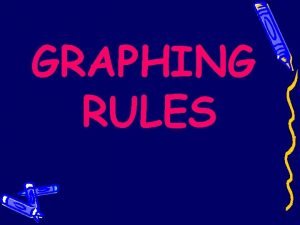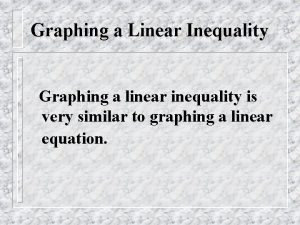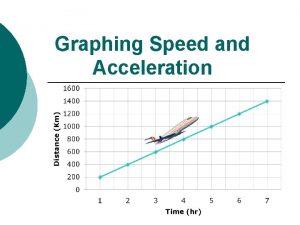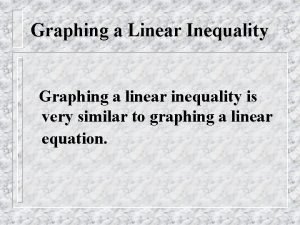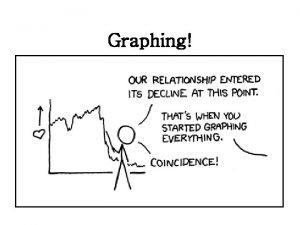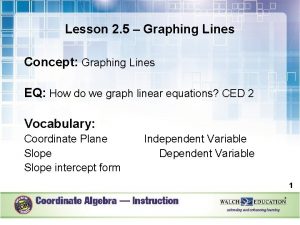Rules for Graphing Rules for Graphing 1 Identify


















- Slides: 18

Rules for Graphing

Rules for Graphing 1. Identify the Independent and Dependent Variables.

Independent vs. Dependent Variables Independent Variable – the variable that the experimenter controls Dependent Variable – the variable that changes as the independent variable changes

Rules for Graphing 2. Determine the range of the independent variable to be plotted.

Rules for Graphing 3. Decide whether the origin (0, 0) is a valid data point.

Rules for Graphing 4. Spread the data out as much as possible. Let each division on the graph paper stand for a convenient unit.

Rules for Graphing 5. Number and Label the Horizontal Axis.

Rules for Graphing 6. Repeat steps 2 -5 for the Dependent Variable.

Rules for Graphing 7. Plot the Data Points on the Graph.

Rules for Graphing 8. Draw the “best fit” straight line or smooth curve that passes through as many data points as possible (Do not connect the dots).

Rules for Graphing 9. Give the graph a title that clearly tells what the graph represents.

Data Analysis Identify relationships between variables from a Data Table, Graph or both.

Graphical Relationships Linear (Direct Proportion) Parabolic (Exponential) Inverse (Hyperbolic)

Linear Relationships Look for a constant rate of increase or decrease in both variables. y = mx + b

Linear Relationships m = slope = rise/run y – intercept = the “y” coordinate where x = 0

Parabolic Relationship Look for a varying rate of increase of one variable w. r. t. the other variable. y = kx 2 k = the rate of increase of the variables.

Inverse Relationships Look for a varying rate of decrease in one variable as the other variable increases xy = k or y = k/x k is a constant that shows the rate of decrease between the variables. DO NOT CONFUSE WITH LINEAR WITH A NEGATIVE SLOPE!

 Vertical axis
Vertical axis Graphing rules
Graphing rules Inequality shading rules
Inequality shading rules Kontinuitetshantering i praktiken
Kontinuitetshantering i praktiken Typiska drag för en novell
Typiska drag för en novell Tack för att ni lyssnade bild
Tack för att ni lyssnade bild Vad står k.r.å.k.a.n för
Vad står k.r.å.k.a.n för Varför kallas perioden 1918-1939 för mellankrigstiden
Varför kallas perioden 1918-1939 för mellankrigstiden En lathund för arbete med kontinuitetshantering
En lathund för arbete med kontinuitetshantering Underlag för särskild löneskatt på pensionskostnader
Underlag för särskild löneskatt på pensionskostnader Personlig tidbok
Personlig tidbok A gastrica
A gastrica Förklara densitet för barn
Förklara densitet för barn Datorkunskap för nybörjare
Datorkunskap för nybörjare Boverket ka
Boverket ka Debattartikel struktur
Debattartikel struktur Delegerande ledarstil
Delegerande ledarstil Nyckelkompetenser för livslångt lärande
Nyckelkompetenser för livslångt lärande Påbyggnader för flakfordon
Påbyggnader för flakfordon

